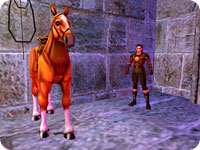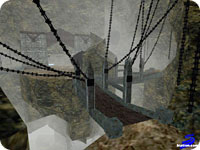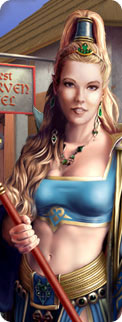
|
Building The Perfect Adventurer
|
Before you jump feet-first into Norrath, take some time to consider the waters into which you’ll be plunging. This is a fantasy world, so your point of reference should be medieval Europe if you’re wondering how your character should act in general. Other players will expect you to stay in character, so they won’t be happy if you start chatting about yesterday’s football games.
They also won’t be happy if you choose to play, for example, an ogre warrior and your character uses flowery speech. Unless, of course, you’re interested in smashing stereotypes, in which case you’ll need to come up with a back story and explain how this particular ogre came to be the way he is. Maybe he was orphaned as a baby and a couple humans found him in the woods and raised him as one of their own. Norrath also has its own back story that you’ll need to consider when creating your character. Humans and ogres don’t normally get along, to continue the previous example, so your ogre warrior’s adoptive parents will have had difficulty while raising him. Perhaps they were loners to begin with, or maybe they were thrown out of their village “for bringing such a monstrosity into it.” Whatever you decide, your back story should be convincing to other characters and consistent with Norrath’s history. Keep in mind that characters who go against accepted norms will probably have to explain their actions a lot, and some players may reject them at face value. |
 An EverQuest Horse, of Course. Not every animal is a fearsome monster.  Feel the Foreboding Gloom. Explore mysterious places. |
Races
There are 14 races in the game. The one you select will limit which classes — such as warrior, magician and so forth — you can choose from to complete your character. Dark elves, dwarves, gnomes, half-elves, halflings, high-elves, iksar, ogres, trolls and wood elves possess a heightened ability to see in the dark.
|
Barbarian: These larger, more rugged relatives of humans hail from the colder northlands. They tend to be less cultured and refined than their cousins. Barbarians can be beastlords, rogues, shamans or warriors.
Dark elves: Don’t choose this race unless you enjoy a challenge. Dark elves live underground and are hated by most inhabitants of Norrath; other elves in particular will usually attack them on sight, and NPCs will generally consider them to be evil and act accordingly. Dark elves can be clerics, enchanters, magicians, necromancers, rogues, shadow knights, warriors or wizards. Dwarves: These short, stocky miners possess exceptional jewelry- and weapon-making skills. They can be clerics, paladins, rogues or warriors. Erudites: They are also relatives of humans, although they consider themselves to be the elite among the races of Norrath. They tend to be snobbish intellectuals who live lavish lifestyles, and they can be clerics, enchanters, magicians, necromancers, paladins, shadowknights, or wizards. Gnomes: Shorter than dwarves or halflings, gnomes know how to build impressive contraptions. Their white hair and brown skin also sets them apart from the other little people roaming the land. They can be clerics, enchanters, magicians, necromancers, rogues, warriors or wizards. Half-elves: Only two races, humans and elves, have ever mated, and half-elves are the result of that cross-breeding. They can be bards, druids, paladins, rangers, rogues or warriors. Halflings: Out-going and happy, halflings have large feet and hands and tend to be more agile than their cousins, dwarves and gnomes. They can be clerics, druids, rogues or warriors. |
High-elves: These tall, lithe creatures consider themselves the royalty of Norrath. They value culture and architecture above all else. They can be clerics, enchanters, magicians, paladins or wizards.
Humans: If you can’t decide what to choose, humans are always a good default option. They’re also good if you’re not entirely comfortable with role-playing and would like to select something closer to home. Humans can be bards, clerics, druids, enchanters, magicians, monks, necromancers, paladins, rangers, rogues, shadow knights, warriors or wizards. Iksar: These lizard people are hated by all the races in Norrath, both good and evil. They can be beastlords, monks, necromancers, shamans, shadow knights or warriors. Ogres: They’re enormous, and not very bright, but ogres are a good choice if you enjoy smashing stuff. Be careful, though, because NPCs view them the same way they view dark elves. Ogres can be beastlords, shadow knights, shamans or warriors. Trolls: NPCs don’t like these guys either. They’re not as big as ogres, but they’re a bit stronger than them. Trolls can be beastlords, shadow knights, shamans or warriors too. Vah Shir: These cat-like people inhabit Norrath’s moon, Luclin. They can be bards, beastlords, rogues, shamans or warriors. Wood elves: They’re the shortest of the elves, but lives spent in the woods make them more agile than their cousins. They can be bards, druids, rangers, rogues or warriors. |

|
Bards: They’re considered the most well-rounded of all the classes in Norrath since they can cast spells (which they do by singing them) and fight in hand-to-hand combat at the same time. The downside is that they don’t excel at either.
Beastlords: These spiritual warriors draw their fighting style from the tactics employed by wild animals, so they prefer small, claw-like weapons such as daggers. They can befriend — and possibly control — animals that will serve and protect them. Clerics: If you’re not interested in fighting, this would be a wise choice. Clerics tend to stay back during battles, healing characters who get hurt and casting spells of protection as often as they can. Their religious faith is very important to them. Druids: This class claims a strong connection to all wild things. Animals will never harm druids, unless they’re provoked (monsters don’t count, of course). They draw their magical abilities from nature. Enchanters: Characters who belong to this class tend to look for ways to take ordinary objects and make them special. Enchanters’ magic lies in the ability to, for example, bind the flame from a torch to a sword to enhance its capacity to cause damage. Magicians: These spellcasters like to use their magic to summon forth creatures that will fight their battles for them. Another class to look at if you don’t want to fight. Monks: Characters who belong to this class can turn their hands and legs into deadly weapons. |
Necromancers: These allies of the shadow knights are inherently evil and will reanimate corpses to fight their battles for them.
Paladins: The antithesis of shadow knights, paladins fight only for good. They are zealously dedicated to their religion. Rangers: If you’d like to roam Norrath as a freelancer (like Kane in the old TV show Kung Fu), a ranger is your best bet. Like druids, they are attuned to nature, but they possess strong fighting abilities. Rogues: Members of this class tend to be solitary, like rangers, but they prefer urban areas to the wilderness. They’re the ones who enjoy political maneuvering and bending the ear of a leader if it will earn them some gold. Shadow knights: These fighters swear their allegiance to evil and can often be found in the company of necromancers. At high levels they gain some of the necromancers’ undead-summoning abilities. Shamans: They are healers, like druids, but they tend to hail from cultures that are more primitive and superstitious. Warriors: Members of this class live to fight. Wizards: As warriors develop their brawn to its fullest, wizards develop their ability to use their minds to cast devastating spells. |
|
Finishing Up
Once you select your race and class, you can decide your character’s appearance, name him or her (offensive or anachronistic names will probably be changed by the people in charge of the game) and select a deity. Your character can be agnostic and choose not to be religious, or he can select one of 16 gods to obey. For example, a cleric might swear allegiance to Rodcet Nife, The Prime Healer, while a necromancer will likely follow Bertoxxulous, The Plague Bringer. After that, you’re ready to receive your basic supplies (they vary by class) and start playing the game. If you want to pick up more hints and tips, visit these web sites:
|

|